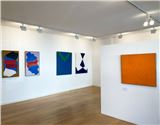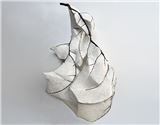Book Review: Amnon David Ar
Technical skill, symbolic imagery, and the personal and cultural narratives within Amnon David Ar鈥檚 paintings
Michael Pearce / 黑料不打烊
15 Jul, 2025

Amnon David Ar, Light Years, by Aya Lurie, Doron Lurie, and Martin Kiefer. Published by Hirmer.
The book is a bright slab, with sturdy card covers cut hard to the hot orange fore-edge of the page block, the brash color matching a split title block printed boldly in tense lower-case letters set in a modernist right-angled sans serif text, cornering a half-naked self-portrait cleverly composed with the image of the artist looking down into a mirror lain flat on the floor. The portrait shows spectacled and hairless Amnon David Ar in his shorts, revelatory, his arm raised in a brushy salutation like an auteur’s greeting embodied in pigment on a frescoed ceiling; an intriguing painterly gesture pointing toward mannerist extravagance.
Cutting the ordinary formalities of empty opening pages and the dull details of publication and author and date which usually begin books, on the first page Aya Lurie and Doron Lurie open their introduction to Ar’s life and work with direct and formidable intent, using biblical authority to explain how he shares the ancient names of King David of Israel and his firstborn son – an inauspicious beginning, considering ignominious Amnon’s incestuous rape of his half-sister, and his drunken death murdered by his half-brother Absalom. But not everything is quite as it seems. In fact, Ar was born bearing the even heavier weight of the names of the more recently deceased. His first name was given to honor the memory of a family friend killed in the Yom Kippur war of 1973, and his second name was given to him as a memorial of Israel’s first Prime Minister, David Ben-Gurion, who died just before the artist was born.
With the lead and load of this blunt beginning, readers might expect to open a gloomy gothic tome of darkness, but inside, the pictured paintings are light, and studied, and pleasant, opening with a study of jumbled chaos examining the torn plastic of a package of paper rolls, gallon tubs of paint, rollers, ink, and sheets of colored paper, all piled onto a studio cart. The image sets the tone for Ar’s work, for although he prioritizes technical expertise and the formal questions of care and composition, balance and color, the painting is dominated by a child’s toy bulldozer in bright hues of green, yellow, and red taking front and center on the cart’s shelf, reminding viewers of a carefree boy’s play. Light prevails even when he directs his attention to a memorial at the close of the book in a photo of a work in progress of a foreshortened body stretched out on the green sheet spread over the block of a hospital bed, a painting of an unfinished father ready to be washed like Mantegna’s dead Christ, loomed over by the memento mori of a medical demonstration model skeleton mounted on a wheeled stainless-steel rod.
Between the foreshortened parentheses of the self-portrait on the cover and the compressed corpse at the end, Ar’s pictures range through the journey of life. He works in three principal areas: reflecting the confusion of many members of the middle class he seems torn between loving the signals of aspirational bourgeois comfort and the symbols of bohemian chaos – he paints a fluffy family dog curled up on ochre rugs beside the sliding door opening onto a patio, a beautifully done potted monstera, and shiny children’s toys. These pleasant images of upward mobility and growing affluence sit a little uncomfortably, though, when alongside proletarian views of shopping streets and images of industrial decay, commercial goods, chrome, and plastics, plastics, plastics, all the conventional subjects of photorealism, although the edge of these once controversial subjects became blunted by reproduction half a century ago, and when he nods to the conventional themes of social justice, checking disability, hinting at homosexuality, and side-eying the uncomfortable dilemmas of class conflict by placing Lenin’s bust beside a child’s spaceman toy, the nod indicates uncomfortable but ordinary middle-class preoccupations. The third grouping of his paintings centers around images concerned with artists’ worries – male and female academic nudes, the skeleton, working out the complex balance of combining abstract shapes with observation, and references to past masters like Diego Velasquez’ Christ Crucified, Gustave Courbet’s L’Origene du Monde (The Origin of the World), and Jan Van Eyck’s convex mirror from the Arnolfini Wedding.
The paintings pictured in the book are a convincing and satisfying series of pleasant aspirational imagery snipped from observations of reality. In paintings all things are always interpretable, despite Frank Stella’s protests they were not, and although these images seem to be random choices briskly plucked from Ar’s life, it is hard to imagine that an artist of his quality, with this training, this illustrative skill, and this thoughtfulness would leave his gentlest subjects to the exigencies of chaos. These are carefully managed, precise choices. Ar has left clues. In the bookend photo of the easel in the whispering room the body is absent. This strange space is a stage set dressed with objects illustrating moments of a constructed life – it’s not a real hospital room: the checkerboard black and white of a freemasons’ lodge is unrolled linoleum spread across the corner, a model of a Luftwaffe Starfighter jet is suspended from the angled ceiling; a German civil defence plaque, a firefighter’s silver helmet, one of Ar’s still life paintings, and airhorns hang on the wall, and – most incongruously – in the foreground an oversize Lego figure of Bob the Builder faces the empty bed. Ar is a clever composer.
An inconsistent book, then, but it is a beginning, and the impressive technical skill Ar shares in it promises a great future should he surpass his desire to please by embracing the unexpected creativity that must enter an artist’s journey if they are to enter the pantheon of the greats. The spirit of invention lurks in all studios, and his next body of ambitious work will surpass this good foundation if he takes the risk to allow inspiration to carry him into the unexpected, into originality, into genius.
For more on auctions, exhibitions, and current trends, visit our Magazine Page

 ARTISTS
ARTISTS







